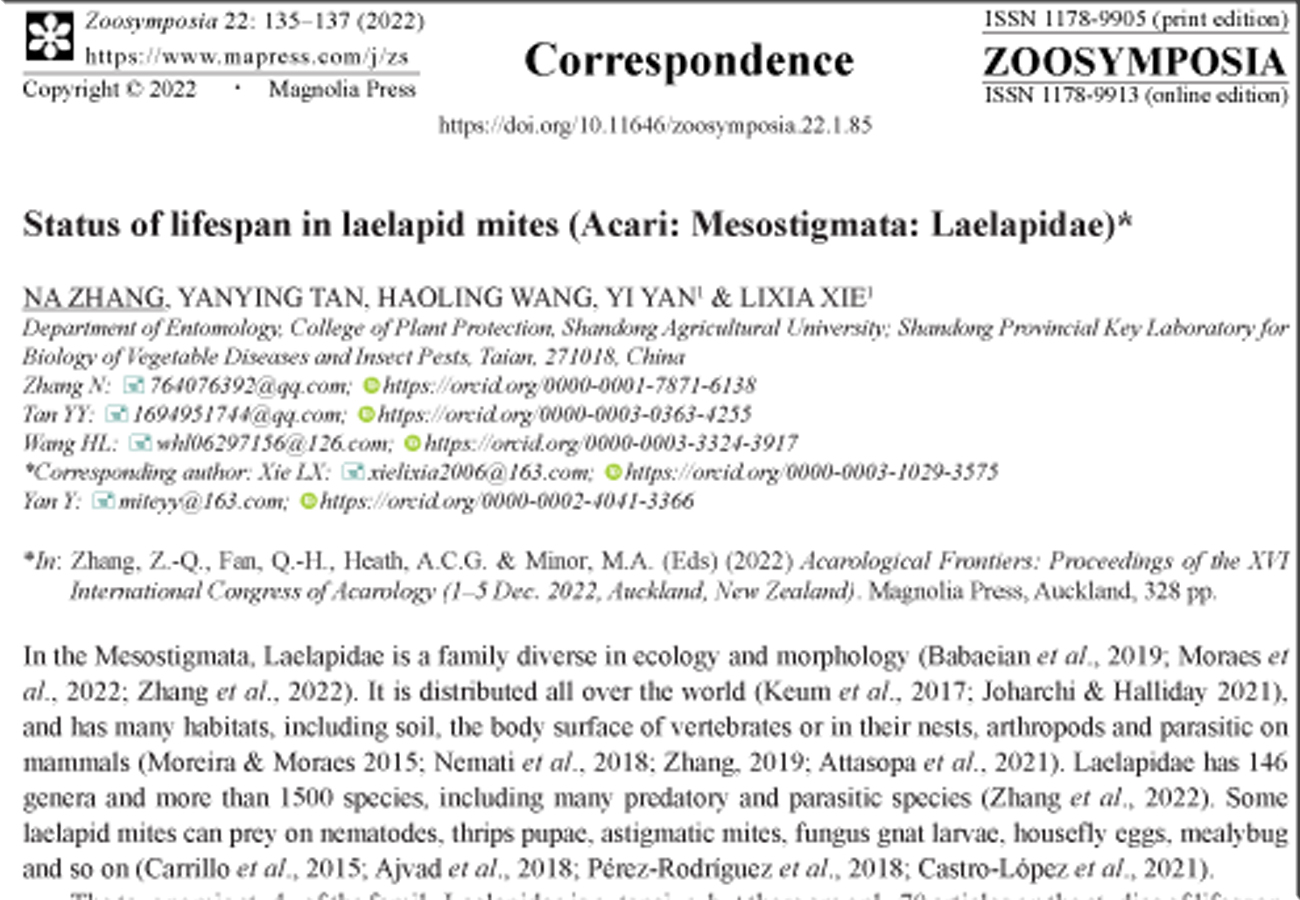Abstract
In the Mesostigmata, Laelapidae is a family diverse in ecology and morphology (Babaeian et al., 2019; Moraes et al., 2022; Zhang et al., 2022). It is distributed all over the world (Keum et al., 2017; Joharchi & Halliday 2021), and has many habitats, including soil, the body surface of vertebrates or in their nests, arthropods and parasitic on mammals (Moreira & Moraes 2015; Nemati et al., 2018; Zhang, 2019; Attasopa et al., 2021). Laelapidae has 146 genera and more than 1500 species, including many predatory and parasitic species (Zhang et al., 2022). Some laelapid mites can prey on nematodes, thrips pupae, astigmatic mites, fungus gnat larvae, housefly eggs, mealybug and so on (Carrillo et al., 2015; Ajvad et al., 2018; Pérez-Rodríguez et al., 2018; Castro-López et al., 2021).
References
Attasopa, K., Chantawannakul, P. & Bänziger, H. (2021) Morphological description, DNA barcodes and phylogenetic placement of a new mite species: Dinogamasus saengdaoae sp. nov. (Mesostigmata: Laelapidae) found in the acarinarium of carpenter bees in Thailand. Systematic and Applied Acarology, 26 (2), 474–495. https://doi.org/10.11158/saa.26.2.11
Ajvad, F.T., Madadi, H., Michaud, J.P., Zafari, D. & Khanjani, M. (2018) Life table of Gaeolaelaps aculeifer (Acari: Laelapidae) feeding on larvae of Lycoriella auripila (Diptera: Sciaridae) with stage-specific estimates of consumption. Biocontrol Science and Technology, 28 (2), 157–171. https://doi.org/10.1080/09583157.2018.1434613
Babaeian, E., Mašán, P. & Halliday, B. (2019) Review of the genus Holostaspis Kolenati, 1858 (Acari: Laelapidae). Zootaxa, 4590 (3), 301–341. https://doi.org/10.11646/zootaxa.4590.3.1
Carrillo, D., de Moraes, G.J. & Pena, J.E. (Eds.) (2015) Prospects for biological control of plant feeding mites and other harmful organisms. Progress in Biological Control, 19, Springer, Cham, pp. xiv + 328 pp. https://doi.org/10.1007/978-3-319-15042-0
Castro-López, M.A., Ramírez-Godoy, A., Osorio, W.M. & Rueda-Ramírez, D. (2021) Predation and oviposition rates of Gaeolaelaps aculeifer and Parasitus bituberosus (Acari: Laelapidae and Parasitidae) on pre-pupae/pupae of Thrips tabaci (Thysanoptera: Thripidae). Acarologia, 61 (2), 394–402. https://doi.org/10.24349/acarologia/20214438
De-Moraes, G.J., Moreira, G.F., Freire, R.A.P., Beaulieu, F., Klompen, H. & Halliday, B. (2022) Catalogue of the free-living and arthropod-associated Laelapidae Canestrini (Acari: Mesostigmata), with revised generic concepts and a key to genera. Zootaxa, 5184 (1), 1–590. https://doi.org/10.11646/zootaxa.5184.1.1
Edler, A. & Solomon, L. (1979) Morphology of preadult stages of Laelaps agilis Koch, 1836 with notes on life history and feeding habits (Acari/Mesostigmata: Laelapidae). Insect Systematics and Evolution, 10 (2), 81–90. https://doi.org/10.1163/187631279X00222
Hosamani, R.K., Gulati, R. & Sharma, S.K. (2006) Bioecology and management of honeybee mite, Tropilaelaps Clareae Delfinado and Baker - A review. Agricultural Reviews, 27 (3), 191–199.
Joharchi, O. & Halliday, B. (2021) A new genus and species of Laelapidae Canestrini from Sri Lanka (Acari: Mesostigmata). Zootaxa, 5048 (3), 391–406. https://doi.org/10.11646/zootaxa.5048.3.5
Keum, E., Jung, C. & Joharchi, O. (2017) New species and new records of the family Laelapidae (Acari: Mesostigmata) from Republic of Korea. Zootaxa, 4353 (3), 485–505. https://doi.org/10.11646/zootaxa.4353.3.5
Meng, Y.C., Lan, M.Y., Zhou, Z.Y. & Li, P.X. (1982) Experimental study on the viability of three species of gamasid mites. Zoological Research, 3, 197–203.
Murphy, P.W. & Sardar, M.A. (1991) Resource allocation and utilization contrasts in Hypoaspis aculeifer (Can.) and Alliphis halleri (G. & R. Can.) (Mesostigmata) with emphasis on food source. In: Schuster, R. & Murphy, P.W. (Eds) The Acari, Dordrecht, Springer, pp. 301–311. https://doi.org/10.1007/978-94-011-3102-5_22
Mustafa, A.M., Mahmoud, H.I., Yassin, E.M.A., Elwan, H.A. & Khalil, A.M. (2016 a) Effect of diets and temperature degrees on the biological aspects of the Laelapid mite, Ololaelaps ussuriensis Bregetova & Koroleva, 1964. Menoufia Journal of Plant Protection, 1 (2), 121–128. https://doi.org/10.21608/MJAPAM.2016.176643
Mustafa, A.M., Shalaby, F.F., Yassin, E., Khalil, A.M. & Shahata, F.E. (2016 b) Biological studies of Laelapid predacious mites, Androlaelaps casalis, berlese and Laelaps astronomicus koch on two food types under three temperature degrees. Menoufia Journal of Plant Protection, 1, 111–119. https://doi.org/10.21608/mjapam.2016.176642
Nemati, A., Gwiazdowicz, D. & Khalili-Moghadam, A. (2018) On Androlaelaps elegantulus (Berlese) and Gaeolaelaps brevipilis (Hirschmann, Bernhard, Greim & Götz) with a key to the Gaeolaelaps mites of Iran. International Journal of Acarology, 44, 227–235. https://doi.org/10.1080/01647954.2018.1487997
Pfingstl, T. & Schatz, H. (2021) A survey of lifespans in Oribatida excluding Astigmata (Acari). Zoosymposia, 20, 7–27. https://doi.org/10.11646/ZOOSYMPOSIA.20.1.4
Pérez-Rodríguez, J., Calvo, J., Urbaneja, A. & Tena, A. (2018) The soil mite Gaeolaelaps (Hypoaspis) aculeifer (Canestrini) (Acari: Laelapidae) as a predator of the invasive citrus mealybug Delottococcus aberiae (De Lotto) (Hemiptera: Pseudococcidae): Implications for biological control. Biological Control, 127, 64–69. https://doi.org/10.1016/j.biocontrol.2018.08.015
Roy, M., Brodeur, J. & Cloutier, C. (2002) Relationship between temperature and developmental rate of Stethorus punctillum (Coleoptera: Coccinellidae) and its prey Tetranychus mcdanieli (Acarina: Tetranychidae). Environmental Entomology, 31, 177–187. https://doi.org/10.1603/0046-225X-31.1.177
Shen, Y.C. (2018) Study on the life span, parasitic mode and transmission route of the Tropilae lapsclareae. Apiculture of China, 69 (08), 38–39.
Walter, D.E. & Oliver, J.H., Jr. (1989) Geolaelaps oreithyiae, n. sp. (Acari: Laelapidae), a thelytokous predator of arthropods and nematodes, and a discussion of clonal reproduction in the Mesostigmata. Acarologia, 30, 293–303.
Wang, X.W (2010) Study on biological characteristics and predation of Hypoaspis chianensis. Fuzhou, China, Fujian Agriculture and Forestry University, pp 26–30.
Wang, B.B. (2011) The predatory mite Androlaelaps casalis: modes of reproduction and temperature dependent life table characteristics on a diet of Tyrophagus putrescentiae. Hefei, China, Anhui Agricultural University, 24 pp.
Zhou, W.Z. (1992) Biological properties of Eulaelaps stabularis. Zoological Research, 13 (1), 53–57.
Zhang, Q. (2019) Studies on the taxonomy and revision of Hypoaspidinae in China. Shandong Agriculture University, Taian, China, 14 pp.
Zhang, N. & Xie, L.X. (2021) The lifespans of the potential biological control agents in the family Blattisociidae (Acari: Mesostigmata). Zoosymposia, 20, 91–103. https://doi.org/10.11646/zoosymposia.20.1.10
Zhang, N., Liu, X.Y., Lu, W.Z., Tan, Y.Y., Xie, L.X. & Yan, Y. (2022) How long do laelapid mites (Acari: Mesostigmata: Laelapidae) live?. Zoosymposia, 21, 37–57. https://doi.org/10.11646/zoosymposia.21.1.4


